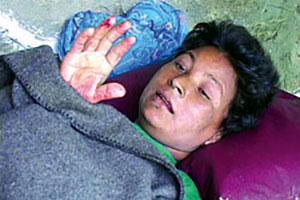The thirty-two-year old Sushila Jaisi of Janali Bandali VDC in Achham, who was raped by an army person died, due to excessive bleeding when an untrained traditional midwife tried to abort her fetus with hot iron road. The very news broadcast through Kantipur Television in 2004 won this year’s International Federation of Journalism Tolerance Prize.
This award-wining piece not only raised concern over urgency in addressing women’s sexual and reproductive health (SRH), but also internationalized the way Nepali women are being victimized in the conflict situation. And how the state apparatus remains silent even during such humanitarian crisis.
The death of Jaisi is obviously a tip of an iceberg. During the decade long armed conflict, women’s SRH has worsened. As armed personnel have been using rape and sexual exploitation as a new tool to suppress the conflict, women continue to die with unsafe abortions.
Media coverage on the plight of Jaisi has clearly depicted the state’s failure to disseminate enough knowledge about the life threatening practices and health services. The very piece also pointed out women’s vulnerability to crimes committed by the state.
The issue raised by private television recently appeared in a daily newspaper. This has highlighted the importance of media in raising the voice of the voiceless. Some health experts have started raising concern over the worsening state of women’s sexual and reproductive health rights. Women are raped at gunpoint for taking revenge. Gang raped, raped by armed personnel and those who are forced to have sex for survival have become a prey to unsafe abortion. Girls as young as nine years are gang raped and such victims are re-traumatized by the denial of their rights to healthy life.
Medical personnel rarely attend their duty in the rural parts where there is more risk for women’s SRH. Many district hospitals lack adequate equipment, besides the lack of trained manpower.
 Despite the fact that rape victims go through serious mental health problems, women are not able to get counselling, let alone medical treatment. Instead they are tabooed. Both the government’s programs and donor-driven projects have failed to make any headway in this area.
Despite the fact that rape victims go through serious mental health problems, women are not able to get counselling, let alone medical treatment. Instead they are tabooed. Both the government’s programs and donor-driven projects have failed to make any headway in this area.
In this scenario, the role of independent media is crucial. Whether it is to discover women’s death due to unsafe abortion or to disclose women’s SRH are not being addressed due to the conflict. Media is the only way to make the women realize how their bodies are being used as a commodity for revenge.
Lets’ take the example of uterus prolapse, for instance. Hundreds of women are suffering through such prolapse, which is basically due to lack of awareness that they should be careful while dealing with heavy loads, especially during pregnancy, pre and post delivery phase. The role of media is crucial in helping such women come out of such possibility of a prolapse. In the country, which has the highest maternal mortality rate in the world that is 539 per 100,000 live births, media can also work as awareness tool. People are not yet aware that investment in the media can really bring instant change in the situation. For example, investing 50,000 rupees for a workshop to let only few people having access to the seminar know about awareness piece would not be as effective as a few seconds’ information disseminated through a radio that would reach many parts of the country. The point to be noted is that, in a country like Nepal, which has very difficult geographical structure and low literacy rate, electronic media like FMs would be useful to disseminate awareness and informative programs.
Despite state’s commitment on International Conference on Population and Development (ICPD), the death of 26-year-old Mansara Dhakal, who was six months pregnant in rural Achham clearly indicates that rural people need to be made aware that the use of contraceptive can avoid the need of an unsafe abortion.
Instead of promotional and commercial advertisement of the condom, a new way out should be searched to make rural people realize the need to use contraceptives. Likewise, it is also necessary to use media in a more effective manner so that it could inject a sense of awareness to the otherwise superstitious rural population of the country.
– Sangeeta Rijal
Via The Kathmandu Post
Jan 3rd, 2006










































